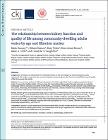| dc.contributor.author | Little, Mark | en |
| dc.contributor.author | Kenny, Rose | en |
| dc.contributor.author | Tobin, Katy | en |
| dc.date.accessioned | 2019-08-22T17:15:19Z | |
| dc.date.available | 2019-08-22T17:15:19Z | |
| dc.date.issued | 2018 | en |
| dc.date.submitted | 2018 | en |
| dc.identifier.citation | Canney, M. and Sexton, E. and Tobin, K. and Kenny, R.A. and Little, M.A. and O'Seaghdha, C.M., The relationship between kidney function and quality of life among community-dwelling adults varies by age and filtration marker, Clinical Kidney Journal, 11, 2, 2018, 259-264 | en |
| dc.identifier.other | Y | en |
| dc.identifier.uri | https://academic.oup.com/ckj/article/11/2/259/4065210 | |
| dc.identifier.uri | http://hdl.handle.net/2262/89301 | |
| dc.description | PUBLISHED | en |
| dc.description | cited By 0 | en |
| dc.description.abstract | Background: The impact of a diminished level of kidney function on the well-being of an older individual is poorly understood. We sought to determine the association between estimated glomerular filtration rate (eGFR) and overall quality of life (QoL) among older adults. Methods: Cross-sectional analysis of 4293 participants from the Irish Longitudinal Study on Ageing, a population-based study of community-dwelling adults 50 years of age and over. We used multivariable negative binomial regression to model the relationship between categories of cystatin C eGFR (eGFRcys) or creatinine eGFR (eGFRcr) and the number of QoL deficits fromthe Control, Autonomy, Self-realization and Pleasure (CASP-19) scale, a holistic measure of QoL among older adults (range 0–57). We further explored this relationship across age strata. Results: Median age was 61 [interquartile range (IQR) 55–68] years, 53% were female, mean (SD) CASP-19 score was 44.8 (7.4) and median eGFRcys was 81 (IQR 68–93) mL/min/1.73 m2. After multivariable adjustment, participants with eGFRcys<45 mL/min/1.73 m2had 14% greater QoL deficits {incidence rate ratio 1.14 (95% confidence interval 1.03–1.25)] relative to the reference group (eGFRcys 90 mL/min/1.73 m2). This relationship appeared linear across eGFRcys categories and was more pronounced in younger (50–64 years) compared with older participants (65–74 or 75 years). There was no substantive relationship between eGFRcrand CASP-19. Conclusions: Cystatin C but not creatinine eGFR was associated with clinically modest declines in QoL among a large sample of community-dwelling older adults. This relationship varied by age, suggesting that a diminished eGFR contributes little to overall QoL beyond middle age in this population. | en |
| dc.format.extent | 259-264 | en |
| dc.language.iso | en | en |
| dc.relation.ispartofseries | Clinical Kidney Journal | en |
| dc.relation.ispartofseries | 11 | en |
| dc.relation.ispartofseries | 2 | en |
| dc.rights | Y | en |
| dc.subject | Age | en |
| dc.subject | Chronic kidney disease | en |
| dc.subject | Creatinine | en |
| dc.subject | Epidemiology | en |
| dc.subject | Quality of life | en |
| dc.subject | Cystatin C | en |
| dc.title | The relationship between kidney function and quality of life among community-dwelling adults varies by age and filtration marker | en |
| dc.type | Journal Article | en |
| dc.type.supercollection | scholarly_publications | en |
| dc.type.supercollection | refereed_publications | en |
| dc.identifier.peoplefinderurl | http://people.tcd.ie/mlittle | en |
| dc.identifier.peoplefinderurl | http://people.tcd.ie/tobink2 | en |
| dc.identifier.peoplefinderurl | http://people.tcd.ie/rkenny | en |
| dc.identifier.rssinternalid | 191254 | en |
| dc.identifier.doi | http://dx.doi.org/10.1093/ckj/sfx084 | en |
| dc.rights.ecaccessrights | openAccess | |
| dc.identifier.orcid_id | 0000-0001-6003-397X | en |




